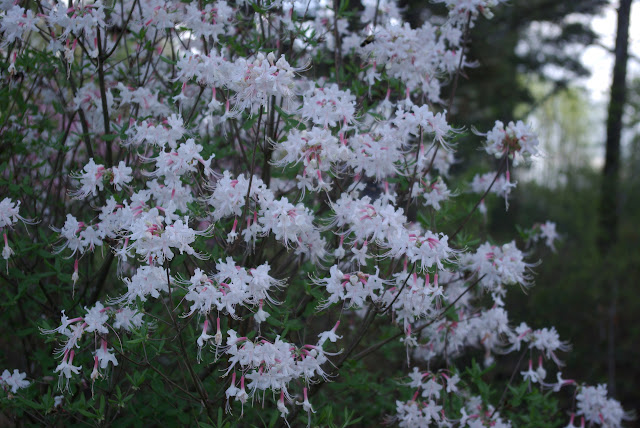The freeze that got the wisteria got the Piedmont and Florida azaleas too, but they were past their prime by then.
The azalea bed looks half empty now that I have moved the evergreen azaleas out. The deer kept chewing them down, and recent cold winters had taken a toll on the Encore azaleas. They had been whittled down to one or two tall slender stalks. With DH's help I moved them to the north and east of the vitex tree in the front yard. I hope they will thrive there and no longer clash with the native Piedmont azaleas, lol. (If you can still see the lonely sad branch of one of the Encores sticking out into the drive.)
Thankfully the deer almost always leave the native azaleas alone. I would legit cry if the deer ate those. Next February or March I plan on setting up a motion detection sprinkler in case the deer try them now that the evergreen azaleas have been moved. Plus, one of the neighbors sold their timber to a logging company so more deer have likely been pushed onto our property. Four of the azaleas are doing beautifully, but I have lost almost every other addition to that bed.
The white piedmont azalea has always performed the best.
It's big, full, sweetly fragrant and very beautiful.

It's big, full, sweetly fragrant and very beautiful.

There's a Piedmont azalea in the middle of the bed that has always struggled in comparison. It only produced a few small clusters of flowers this year, but they are very sweet and the plant is growing, albeit slowly, so I'll leave it where it is.
I will collect some seed from the azaleas this fall in the hopes of eventually getting more like them. In the meantime I plan to order a sweet azalea (Rhododendron arborescens), a Red Hills azalea (R. colemanii), and a couple of Piedmont azaleas for the lower part of the bed, nearest the ditch. Sweet azaleas grow tall, are very fragrant, and grow in swamps and by stream and river banks, so hopefully it will be happy next to the ditch. Red Hills azaleas can also grow tall, has pink, white or yellow flowers and according to Dirr, has a fragrance that can range from sweet to musky to lemony. When I get one I hope it's sweet or lemony.
I saw a beautiful cultivar of a piedmont azalea at the Coker Arboretum this past Wednesday: 'Camellia's Blush'. I love the soft pink color and it's more fragrant than my pink piedmont azaleas.
For the upper part of the bed I'd like to try an Alabama azalea and pinxterflower. They are found on rocky hillsides and dry woods. Alabama azaleas may have the best fragrance of all of the native azaleas, and that's saying something. It's very sweet and smells like vanilla or lemon, depending on the year. There's a treble of beautiful Alabama azaleas at the Coker Arboretum and one day I want an AL azalea like one of those. I had an AL azalea next to the house that performed beautifully for one year and then declined thereafter for no discernible reason. I hope my next attempt is more successful, as an AL is a very special plant.
Today I am joining gail at clay and limestone for her wonderful meme Wildflower Wednesday.

































